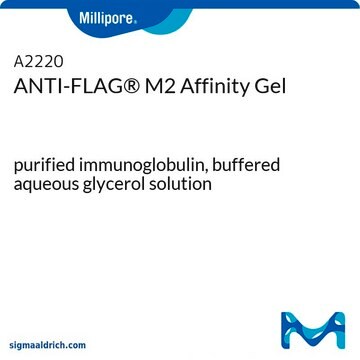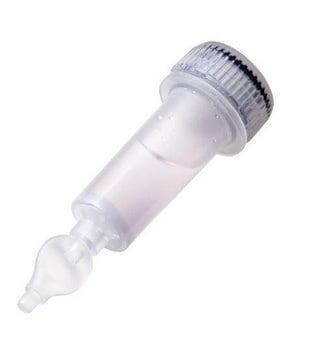Yes, Tris buffers should work.
P6611
Gel de afinidad de níquel HIS-Select®
(1:1 suspension in a 20% ethanol solution)
Sinónimos:
Ni-NTA resin, nickel charged agarose
Seleccione un Tamaño
MXP 4,061.00
Seleccione un Tamaño
About This Item
MXP 4,061.00
Productos recomendados
conjugado
magnetic beads
Nivel de calidad
Formulario
(1:1 suspension in a 20% ethanol solution)
Características
hydrophilic
envase
pkg of 1 mL
pkg of 100 mL
pkg of 25 mL
pkg of 5 mL
pkg of 500 mL
concentración
1.5-2.4 mL/mL (suspension in packed gel)
técnicas
protein purification: suitable
color
faint blue to very dark blue
Matriz
6% Beaded Agarose
capacidad
>15 mg/mL, gel binding capacity (protein)(with an approx. 30 kDa protein)
temperatura de transición
flash point 32 °C (closed cup)
temp. de almacenamiento
2-8°C
Descripción general
Aplicación
Características y beneficios
- Gran selectividad para una mayor pureza.
- El exclusivo enlace hidrófilo sin carga reduce la unión inespecífica.
- La capacidad de unión de la proteína etiquetada con histidina es superior a 15 mg/ml.
- Unión en condiciones desnaturalizantes o no desnaturalizantes.
- Purificación en un solo paso.
- Minimiza las interacciones iónicas no deseadas.
- Mínima lixiviación del níquel.
- Tamaño de la microesfera: 45 - 165 μm.
Ligadura / enlace
Forma física
Almacenamiento y estabilidad
Información legal
Producto relacionado
Palabra de señalización
Warning
Frases de peligro
Consejos de prudencia
Clasificaciones de peligro
Flam. Liq. 3
Código de clase de almacenamiento
3 - Flammable liquids
Clase de riesgo para el agua (WGK)
WGK 3
Punto de inflamabilidad (°F)
89.6 °F - closed cup
Punto de inflamabilidad (°C)
32 °C - closed cup
Elija entre una de las versiones más recientes:
Certificados de análisis (COA)
¿No ve la versión correcta?
Si necesita una versión concreta, puede buscar un certificado específico por el número de lote.
¿Ya tiene este producto?
Encuentre la documentación para los productos que ha comprado recientemente en la Biblioteca de documentos.
Los clientes también vieron
Contenido relacionado
Protein purification techniques, reagents, and protocols for purifying recombinant proteins using methods including, ion-exchange, size-exclusion, and protein affinity chromatography.
Técnicas, reactivos y protocolos de purificación de proteínas para purificar proteínas recombinantes utilizando métodos como la cromatografía de intercambio iónico, de exclusión por tamaño y de afinidad.
Tecnologías de expresión de proteínas para varios sistemas de expresión que propician la investigación, la terapéutica y la producción de vacunas.
Protein expression technologies for various expression systems supporting research, therapeutics, and vaccine production.
-
Can Tris buffers be used instead of phosphate buffer for HIS-Select® Nickel Affinity Gel, Product P6611?
1 answer-
Helpful?
-
-
Can imidazole be used with HIS-Select® Nickel Affinity Gel, Product P6611?
1 answer-
For column chromatography, no more than 20 mM is suggested in the extract, equilibration, and wash buffers to prevent non-specific binding of proteins. No more than 250 mM is suggested for the elution buffers. Many proteins will elute with imidazole levels as low as 100 to 200 mM. For batch methods the imidazole concentration may have to be reduced or eliminated.When a protein is expressed at low levels, the presence of the imidazole limits the binding of the protein in the batch method but not when used in a column.
Helpful?
-
-
What is the Department of Transportation shipping information for this product?
1 answer-
Transportation information can be found in Section 14 of the product's (M)SDS.To access the shipping information for this material, use the link on the product detail page for the product.
Helpful?
-
-
What needs to be done if the HIS-Select® Nickel Affinity Gel, Product P6611, resin turns brown on reuse?
1 answer-
During purification many protein extracts tend to discolor an affinity gel during the loading step. The original color will return after the wash or elution step. If the color is still not changing strip and recharge the affinity gel with nickel. Wash with EDTA and recharge with Nickel solution.
Helpful?
-
-
Can I use SDS with HIS-Select® Nickel Affinity Gel, Product P6611?
1 answer-
0.1% SDS has been used with some samples, with no adverse effects on the observed protein binding. However, SDS will effectively coat proteins and may block the binding to the column. It is probably very protein-specific and an SDS concentration that works for one protein may not work for another.
Helpful?
-
-
Why won't my recombinant protein with a histidine-containing tag bind to HIS-Select® Nickel Affinity Gel, Product P6611?
1 answer-
Verify the pH and composition of sample and equilibration buffers. Make sure there are no chelating or reducing agents present in the extraction buffer. If using the batch mode, remove imidazole. Run the affinity purification under denaturing conditions. Run a Western blot of the extract to verify that the recombinant protein is present.
Helpful?
-
Active Filters
Nuestro equipo de científicos tiene experiencia en todas las áreas de investigación: Ciencias de la vida, Ciencia de los materiales, Síntesis química, Cromatografía, Analítica y muchas otras.
Póngase en contacto con el Servicio técnico







